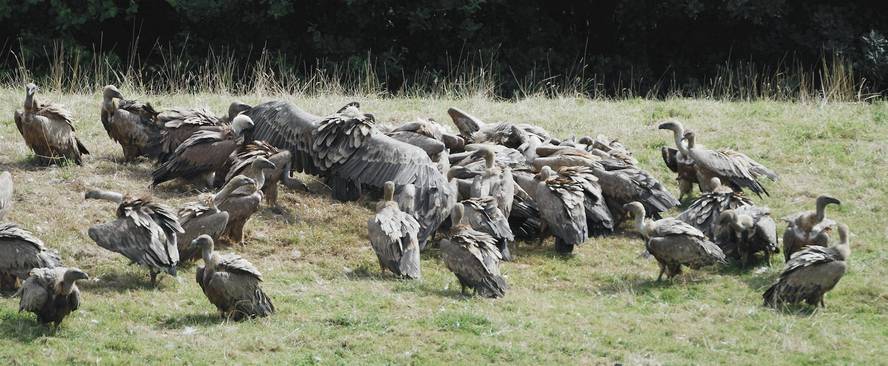Looking for the future of vultures
The bushes are birds of enormous size that, despite their advantages in nature, has led them to become losers in zones dominated by man, as in the Basque Country, leaving without possibility to hide from the eyes of the main enemies. It is no wonder, therefore, that the three species that inhabit the Basque Country are threatened and in need of norms that protect them.
Sometimes another species arrives, but among us coexist three species of coachmen: the bearded vultures (Gypaetus barbatus), the alimoche (Neophron percnopterus) and the griffon vulture (Gyps fulvus). Although the populations of the first two are very limited, the griffon vulture is quite accused and abundant. Although the three have differentiated characteristics, the feeding equips them: the whole figure is specially adapted to the location and swallowing of corpses, such as the way of flying and the cornices of the rocks chosen to nest.
Thus, most of the protection measures of these species will be similar. Taking advantage of the opportunity granted to complete the Protection Law, the preparation of a single Management Plan for three in the Autonomous Community of the Basque Country (CAPV) has begun.
The main conditions that must be met to maintain the populations of a given species can be grouped into two large groups: the suitability of habitats and the availability of sufficient food. In fact, there is a third agent, which is the perception that humans have of these animals. They are usually two types of attitudes. On the one hand, its benefit as a body cleaner has been widely recognized. But, on the other hand, the aggressions that have occurred in recent years to live cattle have caused that a contrary position has often been imposed, especially among those directly related to livestock. Therefore, a section of the Plan recalls the prohibition of attacking or disturbing directly the category of legally protected species.
As for the habitat, our coachmen travel half of their life in the air and their main landing areas (rocky and mountain pastures) are usually solitary. Thus, the obligations of the management plan are complemented by general provisions in which the lands that need most to be fed are called "zones of special food interest" and, within them, those in which white vultures or breasts are essential to nidify or survive. The main objective of these denominations is that these birds suffer the least damage possible for our cause.
The question of food is totally different. And undoubtedly the issue that has generated the most problems in recent decades. The population of griffon vultures has exceeded the appropriate limits. But, are overpopulation and birds real dissatisfaction? To answer these questions it is convenient to know the data. According to population data, the griffon vulture has reached thousands in two decades of its almost disappearance, and is still booming. For example, in 2009, 2,783 Alimoches were recorded in Navarre in the territory with more griffon vultures, and the same has happened in the bordering territories.
With this proliferation, the griffon vultures have reached areas that have "never" been seen and have awakened the concerns and fears generated by what we know. On the other hand, there are those who say they have changed behavior. They say they have begun to attack the living cabin, and that the reason is evident, since by proliferating they need so much food and, as the remains found are insufficient, they begin to feed on living animals.
Vultures have always tried to take advantage not only of bodies, but also of animals incapacitated in one way or another, as those that remain chained in the excrements of rocks or those that have problems during childbirth. It is reasonable that as the number of coaches increases, this type of attack will also increase, but there is a way too long to conclude that they are too many.
To find out if there are too many coachmen, it is necessary to compare the food needs of the current populations with the possible supply of food (extensive livestock bodies in mountains). In the last 15 years there has been an increase in the number of cattle heads (bovine and mares) and a decrease in sheep, as well as an increase in the live weight. Given that in extensive pastures about 5% of the annual cattle hut dies, the annual food supply is close to 2.000 t.
And the need for food? Since each bird needs between 1 and 1.5 kg daily (depending on the season of the year) and that in the CAPV and its surroundings there are about 2,000 birds, it is necessary between 800 and 1,200 t annually. There are other species of animals that take advantage of dead animals such as fox or boar. For these animals, however, they are sporadic foods and do not have great influence on the estimated amounts.
Therefore, it is clear that the offer of food meets the needs of food. However, the offer of food is not regular, but to this situation they are necessarily well adapted. When they can eat as much as possible and can spend more than a month without trying the snack.
There is another important circumstance in these food bills. Due to the disease of mad cows, in 2002, European legislation established the withdrawal of dead animals and the need for special treatment. This law could mean a decrease in the food supply of the coachmen and a decrease in the population. The truth is that nothing similar has happened in the Basque Country, especially because it is very difficult to comply with this legislation: most animals die on the mountain and when the owner goes, it is eaten.
Now it is no longer a problem and the legislation has been streamlined. It allows the abandonment of bodies of animals in the mountain provided certain hygienic-sanitary conditions are met.
This is the management plan carried out by the aforementioned management plan. The mountains of the Natura 2000 Network of the CAPV have been declared as zones of protection for the feeding of the coachmen, since they are the lands in which almost all the animals that grow in extensive livestock are concentrated.
In short, it emphasizes the importance of mountain cattle for the survival of the animal carriages species.
Taking into account these premises, it is clear that extensive livestock and the growing integration of nature conservation result in the benefit of natural heritage and indirectly in society.
If you want to guarantee the future of the coarse species, it is essential to try to combine different perspectives so that economic and ecological interests are complementary in those cases where they can be opposed.







